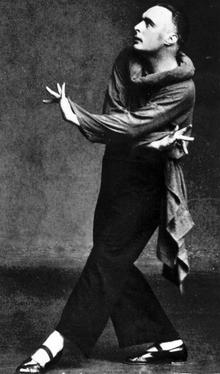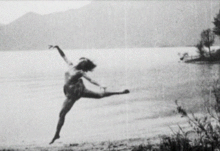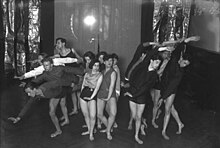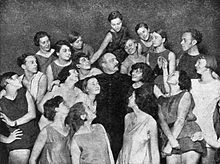Rudolf von Laban
You can helpexpand this article with text translated fromthe corresponding articlein German.(January 2022)Click [show] for important translation instructions.
|
Rudolf von Laban | |
|---|---|
 | |
| Born | Rudolf Laban 15 December 1879 |
| Died | 1 July 1958(aged 78) |
| Known for | Choreography,dance theory,Labanotation |
| Notable work | Labanotation(a movement notation system) |
| Movement | Expressionist dance |
| Partner | Lisa Ullman |
Rudolf(von)Laban,also known asRudolph von Laban(Hungarian:Lábán Rudolf;[1]15 December 1879 – 1 July 1958),[2]was anAustro-Hungariandance artist,choreographer,and movement theorist. He is considered a "founding father ofexpressionist dance"[3]and a pioneer ofmodern dance.[4]His theoretical innovations includedLaban movement analysis(a way of documenting human movement) andLabanotation(a movement notation system), which paved the way for further developments in dance notation and movement analysis. He initiated one of the main approaches todance therapy.[5]His work ontheatricalmovement has also been influential.[6]He attempted to apply his ideas to several other fields, includingarchitecture,education,industry,andmanagement.[4]
Following a dress rehearsal of Laban's last choral work,Of the Warm Wind and New Joy,which he had prepared for the1936 Summer Olympicsin Berlin,Joseph Goebbelscancelled the piece[7]after which time Laban fell out of favor with theNational Socialistgovernment. He eventually left Germany for England in 1937 after four years of working with the Nazi regime.[8]Between 1945 and 1946, he and his long-term collaborator and former studentLisa Ullmannfounded the Laban Art of Movement Guild inLondon,and the Art of Movement Studio inManchester,where he worked until his death. TheTrinity Laban Conservatoire of Music and Dancein London has continued this legacy.
Life and work
[edit]This sectionneeds additional citations forverification.(August 2022) |

Laban was the son of Rudolf Laban Sr. (1843–1907), a militarygovernorinPressburg(Pozsony)[2]and (from 1899)field marshalin theAustro-Hungarian Armyin the provinces ofBosnia-Herzegovina,[9]and Marie (née Bridling; 1858–1926).[2]In 1897, Laban senior was ennobled by the Hungarian monarchy in recognition of his military merit and received the nobiliary predicate "de" to his family name (choosingLaban deVáralja;a place name associated with the Laban family), whereupon Laban junior was rightly entitled to use "von"in his family name in the German-speaking world.[2]Laban grew up in the courtly circles ofViennaandSarajevo.
At a young age, Laban joined acsárdásdance group. At age 15 Laban entered theTheresian Military Academy,but later turned his back on military service. In 1899, Laban moved toMunichand began studying at the Academy of Fine Arts (Akademie der bildenden Künste). There Laban met the painter Martha Fricke fromHanover,whom he married on 15 December 1900. They moved toArcisstr 44,where their daughter Azraela was born in 1901.
Parallel to Laban's studies at the art academy, he took courses at the newly opened teaching and experimental studio for free and applied art (Lehr- und Versuchsatelier für Freie und Angewandte Kunst). There Laban met his future friend Hermann Obrist, who ran the nature studies course. In 1904 Laban decided to leave Munich to visit the most famous art school in Europe, theÉcole des Beaux-ArtsinParisto studyarchitecture.
Laban's son, Arpad, was born in Paris in 1905. After three years of a fulfilledbohemian lifestylewith his wife, Martha Fricke died suddenly. Barely two months after the death of Laban's wife, his father also died, who had made it possible for Laban to lead an independent life with substantial financial support. From then onwards, Laban's two children grew up with their maternal grandparents.
In the years that followed, Laban led an unsteady life between Paris and Vienna,SanremoandNice.Financially bankrupt, Laban completed an apprenticeship as anaccountantin Nice, from which he also successfully graduated. That was to be Laban's only encounter with a regular working life.
Living with his mother in Vienna, Laban made a living as a graphic artist and caricaturist. Laban drew for the magazinesSimplicissimusandJugendand continued the studies he had begun in Paris on historical dance forms. At a cultural event, Laban met the singer Maja Lederer from Munich and married her on 8 May 1910 inPressburg.In the same year, they moved to Munich. With his second wife, Laban moved into a dwelling inSchwabingatHohenzollernstraße 120.
In 1911, Laban rented a room in a rear building in Munich'sTheresienstraße,which he set up as a makeshift movement studio. Laban couldn't make a living with his school; he had to continue working as a commercial artist and caricaturist. Overworked to the point of exhaustion, Laban collapsed in 1912 and went to theLahmann-Sanatorium Weißer HirschnearDresdenfor a cure, where patients were cared for according to the life-reform (Lebensreform) principles.[10]In this natural healing institution, Laban met and fell in love withSuzanne Perrottet,who was also a patient there. In the years that followed, a largely harmonious triangular relationship developed between Perrottet, Laban and his wife.


Perrottet was to become Laban's most important collaborator (along withMary WigmanandKatja Wulff),[10]lover and mother of his child Allar Perrottet (later André Perrottet von Laban) inAsconaandZürich.During theFirst World War,Laban created a school on the natural healing colonyMonte Veritàin the Swiss canton ofTicino,in the municipality ofAscona,which soon attracted many followers of the new dance art.[11]It was here that Laban conducted his famous summer dance courses from 1913 to 1919. Here the students also strived to live in harmony with nature by growing their own food, vegetarianism, weaving cloth and making their ownreform-style clothing,and dancing in the great outdoors nature often nude experimenting with dynamic improvisations.[11][12]Here Laban experienced his intellectual and artistic breakthrough, celebrating the "neuen Menschen","Fiur-Menschen","Anarchos",and"Orgiastos"in expressionist dance dramas.[11]
In 1915 Laban, his wife and their two children and Perrottet and son Allar moved toHombrechtikonnear Zürich. There, the extended family lived a self-sufficient lifestyle similar to that on Monte Verità, growing their own food, doing a lot of manual work and sewing their own clothes (e.g. Perrottet developed comfortable clothing for everyday work and dance, which can be attributed to thedress reform movement). At the same time, Laban founded a school for the art of movement (Schule für Bewegungskunst) in Zürich. It included interdisciplinary dance art, pantomime, improvisation and experiments with the body, voice, instruments, texts and even drawing. Later Laban only mentioned the terms: form, sound, word.
The conclusion of a large vegetarian and pacifist congress at the end of summer 1917 on Monte Verità in Ascona was the three-part dance dramaSang an die Sonneto a text byOtto Borngräber.It began with the setting of the sun, which was followed by the dance of the demons of the night. This part was staged at midnight high in the mountains in front of poet-prophetGustav Gräser's rock grotto. The face masks were created by theDadaistMarcel Janco.Early in the morning the rising, "victorious" sun was greeted as an expression of the hope of overcoming the war and a utopian higher development of mankind. At these performances worked alsoMary Wigman,Sophie Taeuberand Suzanne Perrottet.
Freemasonry
[edit]Laban had been a member of aFreemasonassociation since 1913, and had founded his own masonic lodge "Johannis lodge of ancient Freemasons of the Scottish-and-Memphis-and-Misraim-Rites in the valley of Zürich" which had six brothers and ten sisters.[13]Whilst on Monte Verità, Laban met the occultistTheodor Reuss,who had been on Monte Verità for some time and had established a local Freemason lodge.[13]On 24 October 1917, Reuss issued a charter to Laban andHans Rudolf Hilfiker-Dunn(1882–1955) to operate a III°Ordo Templi OrientisLodge in Zürich calledLibertas et Fraternitas.[13]
Weimar Germany
[edit]
After the end of World War I, Laban returned to Germany. The Zürich Laban School was taken over and continued by Perrottet. After an interlude inStuttgart,where Laban worked with the painterMax Ackermann,Laban founded theTanzbühne Laban(Dance Stage Laban) inHamburg,Weimar Germanyin 1922.
The first public performance of a dance poem by Laban took place inLübeckin the autumn of 1922 in the State Theatre. They called the performance poster byKarl Gatermann the ElderDer schwingende Tempel(The Swinging Temple), archived under the number PLK-Laban 29 in the Dance ArchiveLeipzig.In 1923, the first Laban school was founded, which had its own movement choir. The numerous graduates of the Hamburg School successfully carried Laban's method on to various cities in Germany and Europe. In the years that followed, 24 Laban schools were set up across Europe.
In addition, Laban built up a "Choreographic Institute" inWürzburg(1926/27) andBerlin(1928/29). Together with Dussia Bereska, Laban also directed the Chamber Dance Stage (Kammertanzbühne) (1925–1927). Bereska from the Laban School in Hamburg features in the popular 1925 German cultural silent filmWege zu Kraft und Schönheit(Ways to Strength and Beauty) performingDie Orchidee(The Orchid); also featuring in the same film is Mary Wigman and her dance group and the end scene from Laban's dance dramaDas lebende Idol(The living Idol) where Laban himself makes an appearance.
From 1930 to 1934, Laban took over the direction of the ballet of theBerlin State Opera.Laban integrated the ideas of psychologistCarl Jung,[14]and in Laban's warm up program the practices ofJoseph Pilates,whom according to Pilates, Laban had observed whilst Pilates was working with patients in Hamburg.[15]
Laban under National Socialism
[edit]Laban directed major festivals of dance under the funding ofJoseph Goebbels' propaganda ministry from 1934 to 1936.[16]Laban even wrote during this time that "we want to dedicate our means of expression and the articulation of our power to the service of the great tasks of ourVolk(People). With unswerving clarity ourFührerpoints the way ".[17]In 1936 Laban become the chairman of the association "German workshops for dance" and received a salary of 1250ℛℳper month,[18]but a duodenal ulcer in August of that year bed bound him for two months, eventually leading him to ask to reduce his responsibilities to consultancy.[19]This was accepted and his wage reduced to 500 ℛℳ, Laban's employment then ran until March 1937 when his contract ended.[20]
Several allegations of Laban's attachment toNazi ideologyhave been made, for instance, as early as July 1933 Laban was removing all pupils branded as non-Aryanfrom the children's course he was running as a ballet director.[21]However, some Laban scholars have pointed out[22]that such actions were necessary for survival in Nazi Germany at that time, and that his position was precarious as he was neither a German citizen nor aNazi partymember. In fact, the seizure of power by theNational Socialistsin 1933 had an immediate effect on Laban's work through the new law passed against racial overcrowding in German schools and universities of 25 April 1933 (Gesetz gegen die Überfüllung deutscher Schulen und Hochschulen), Laban was thus bound by this new law of vetting students with the racial characteristic of a "non-Aryan" descent. His work under the Nazi regime culminated in 1936 with Goebbel's banning ofVom Tauwind und der Neuen Freude(Of the Spring Wind and the New Joy), a choreography intended for the1936 Summer Olympicsin Berlin, for not furthering the Nazi agenda.[23][24]
England
[edit]In very poor health, Laban managed to travel to Paris in August 1937.[25]Eventually, he was invited to England, where in February 1938 he joined up with two of his former studentsKurt JoossandSigurd Leederat the Jooss-Leeder Dance School they had founded atDartington HallinDevon(thanks to the philanthropy ofLeonard Elmhirstand his wifeDorothy Whitney), where innovative dance was already being taught by other refugees from Nazi Germany.[26]
Laban was greatly assisted in his dance teaching during these years by his close associates and long-term partnersLisa Ullmannand Sylvia Bodmer.[27]Their collaboration led to the founding of the Laban Art of Movement Guild (now known asTrinity Laban Conservatoire of Music and Dance) in 1945 and The Art of Movement Studio inManchesterin 1946.[27]
In 1947, together with management consultant Fredrick Lawrence, Laban published a bookEffort,Fordisticstudy of the time taken to perform tasks in the industrial workplace and the energy used.[27]Laban tried to provide methods intended to help eliminate"shadow movements"(which he believed wasted energy and time) and to focus instead on constructive movements necessary to the job at hand. Laban publishedModern Educational Dancein 1948 when his ideas on dance for all including children were taught in many British schools. Laban died in England in 1958.
Notable Laban dance students and associates
[edit]Among Laban's students, friends, and associates wereMary Wigman,Suzanne Perrottet,Katja Wulff,Kurt Jooss,Lisa Ullmann,Albrecht Knust, Dussia Bereska,Lilian Harmel,Sophie Taeuber-Arp,Hilde Holger,Ana Maletić,Milča Mayerová,Gertrud Kraus,Gisa Geert,Warren Lamb,Elizabeth Sneddon,Dilys Price,Yat Malmgren,Sylvia Bodmer,Betty Meredith-Jones,andIrmgard Bartenieff.
Legacy
[edit]TheLaban Collection in the Laban ArchiveatTrinity Laban Conservatoire of Music and Dancedocuments Laban's life and work in the 1920s-1950s. TheRudolf Laban Archive at the National Resource Centre for Dance,collected and organised byLisa UllmannandEllinor Hinks,documents his educational work in the UK and contains many of his original drawings. The John Hodgson Collection in the Brotherton Library at Leeds University holds original documents relating to Laban's career in Europe in the early twentieth century. Other archives holding material about Laban include the Tanzarchiv Leipzig, Dartington Archive, and theGerman Dance Archives, Cologne.
Laban's students went on to found their own schools of modern dance, influencing their own pupils through the 20th century:
- Rudolf von Laban
Works and publications
[edit]- (Undated).Harmonie Lehre Der Bewegung(German). (Handwritten copy by Sylvia Bodmer of a book by Rudolf Laban)London: Laban CollectionS. B. 48.
- (1920).Die Welt des Taenzers[The world of Dancers] (German). Stuttgart: Walter Seifert. (3rd edition, 1926)
- (1926).Choreographie: Erstes Heft(German). Jena: Eugen Diederichs.
- (1926).Gymnastik und Tanz(German). Oldenburg: Stalling.
- (1926).Des Kindes Gymnastik und Tanz(German). Oldenburg: Stalling.
- (1928).Schrifttanz: Methodik, Orthographie, Erlaeuterungen(German). Vienna: Universal Edition.
- (1929). "Das Choreographische Institut Laban" inMonographien der Ausbildungen fuer Tanz und Taenzerische Koeperbildung(German). Edited by Liesel Freund. Berlin-Charlottenburg: L. Alterthum.
- (1947). with F. C. Lawrence.Effort: Economy of Human MovementLondon: MacDonald and Evans. (4th reprint 1967)
- (1948).Modern Educational Dance.London: MacDonald and Evans. (2nd Edition 1963, revised by Lisa Ullmann)
- (1948). "President's address at the annual general meeting of the Laban art of movement guild".Laban Art of Movement Guild News Sheet.1 (April): 5–8.
- (1950).The Mastery of Movement on the Stage.London: MacDonald and Evans.
- (1951). "What has led you to study movement? Answered by R. Laban".Laban Art of Movement Guild News Sheet.7 (Sept.): 8–11.
- (1952). "The art of movement in the school".Laban Art of Movement Guild News Sheet.8 (March): 10–16.
- (1956).Laban's Principles of Dance and Movement Notation.London: MacDonald and Evans. (2nd edition 1975, annotated and edited by Roderyk Lange)
- (1960).The Mastery of Movement.(2nd Edition ofThe Mastery of Movement on the Stage), revised and enlarged by Lisa Ullmann. London: MacDonald and Evans. (3rd Edition, 1971. London: MacDonald and Evans) (1st American Edition, 1971. Boston: Plays) (4th Edition, 1980. Plymouth, UK: Northcote House)
- (1966).Choreutics.Annotated and edited by Lisa Ullmann. London: MacDonald and Evans.
- (1974).The Language of Movement; A Guide Book to Choreutics.Annotated and edited by Lisa Ullmann. Boston: Plays. (American publication ofChoreutics)
- (1975).A Life For Dance; Reminiscencs.Translated and annotated by Lisa Ullmann. London: MacDonald & Evans. (Original German published 1935.)
- (1984).A Vision of Dynamic Space.Compiled by Lisa Ullmann. London: The Falmer Press.
References
[edit]- ^An old source (Samuel Thornton,Laban's Theory of Movement: A New Perspective,Plays, 1971, p. 3) giving the birth nameLábán Rezső Keresztelő Szent János Attilais considered discredited and anecdotal as per Suzanne Walther,Dance of Death: Kurt Jooss and the Weimar Years,Routledge, 2013, p. 41 n. 11.
- ^abcdVojtek, Miklós (1999)."Lábán Rudolf pozsonyi gyökerei"[The roots of Rudolf in Bratislava] (in Hungarian). Bratislava: Kalligram Publishing House.Retrieved2022-01-31.
- ^Dörr, Evelyn (2008).Rudolf Laban, The Dancer of the Crystal.Lanham, Maryland: Scarecrow Press. pp. 99–101.ISBN9780810860070.
- ^abMcCaw, Dick (2011)."The Laban Sourcebook".London, New York: Routledge Taylor & Francis. p. 1.ISBN9780415543330.
- ^Levy FJ (1988). "Laban movement analysis and dance therapy in the United States".Dance/movement therapy: a healing art(PDF).Reston, Va.:National Dance Association.pp. 131–164.ISBN0-88314-380-1.Archived(PDF)from the original on 21 January 2022 – viaInstitute of Education Sciences.
- ^Evans M (2009).Movement training for the modern actor(PDF).New York: Routledge. p. 17.ISBN9780203883549.Archived(PDF)from the original on 2 November 2018 – viaCoventry University.
- ^Lilian Karina inKarina, Lilian; Marion Kant (2004).Hitler's Dancers: German Modern Dance and the Third Reich.Translated by Jonathan Steinberg. New York: Berghahn Books. p. 18.
- ^Franco, Susanne (2012). "Rudolf Laban's Dance Film Projects". In Manning, Susan; Ruprecht, Lucia (eds.).New German Dance Studies.Chicago: University of Illinois Press. p. 64.ISBN9780252078439.
- ^Hodgson, John (2016).Mastering Movement, The Life and Work of Rudolf Laban.New York: Routledge, Taylor & Francis Group. p. 17.ISBN9781135860868.Retrieved2022-01-30.
- ^abDörr 2008,pp. 24–45.
- ^abcNicholas, Larraine (2007).Dancing in Utopia.Binsted, England: Dance Books. pp. 36–41.ISBN9781852731212.Retrieved2022-01-29.
- ^Savrami, Katia (2019).Tracing the Landscape of Dance in Greece.Newcastle upon Tyne: Cambridge Scholars Publishing. pp. 26–27.ISBN9781527543331.
- ^abcDörr 2008,pp. 67–68.
- ^Hodgson 2016,p. 72.
- ^Rincke, Eva (2015).Joseph Pilates, Die Biografie[Joseph Pilates, The Biography] (in German). Feiburg im Breisgau: Verlag Herder. pp. 96–97, 147, 173.ISBN9783451600425.Retrieved2022-01-31.
- ^Manning, Susan. "Reinterpreting Laban" a review of "Body-Space-Expression: The Development of Rudolf Laban's Movement and Dance Concepts" by Vera Maletic.Dance Chronicle,Vol. 11, No. 2 (1988), pp. 315–320.
- ^Rudolf Laban, "Meister und Werk in der Tanzkunst," Deutsche Tanzzeitschrift, May 1936, quoted inHorst Koegler,"Vom Ausdruckstanz zum 'Bewegungschor' des deutschen Volkes: Rudolf von Laban," in Intellektuellen im Bann des National Sozialismus, ed. Karl Corino (Hamburg: Hoffmann & Campe, 1980), p. 176.
- ^Karina, Lillian & Kant, Marion, 2003 (translator: Steinberg, Jonathan). "Hitler's Dancers: German Modern Dance and the Third Reich", New York & Oxford: Berghahn Books, p. 244.
- ^Karina, Lillian & Kant, Marion, 2003 (translator: Steinberg, Jonathan). "Hitler's Dancers: German Modern Dance and the Third Reich", New York & Oxford: Berghahn Books, p. 254.
- ^Karina, Lillian & Kant, Marion, 2003 (translator: Steinberg, Jonathan). "Hitler's Dancers: German Modern Dance and the Third Reich", New York & Oxford: Berghahn Books, p. 256.
- ^Karina, Lillian & Kant, Marion (translator: Steinberg, Jonathan). "Hitler's Dancers: German Modern Dance and the Third Reich", New York & Oxford: Berghahn Books, 2003.
- ^Preston-Dunlop, Valerie. "Rudolf Laban An Extraordinary Life" (Dance Books, 1998) (especially Chap. 9 'The Nazification of Culture' and Chap. 10 'Survival').
- ^Toepfer, Karl Eric (1997).Empire of Ecstasy: Nudity and Movement in German Body Culture, 1910–1935.Berkeley, Los Angeles, Oxford: University of California Press. p. 315.ISBN9780520918276.
- ^Kew, Carole. "From Weimar Movement Choir to Nazi Community Dance: The Rise and Fall of Rudolf Laban's" Festkultur "".Dance Research: The Journal of the Society for Dance Research,Vol. 17, No. 2 (1999): pp. 73–96.
- ^Preston-Dunlop 1998, pp. 201-203.
- ^Preston-Dunlop 1998, p. 204.
- ^abcMcCaw 2011,p. XVIII.
External links
[edit]- Guide to the Rudolf Laban Icosahedron.Special Collections and Archives, The University of California Irvine Libraries, Irvine, California
- Rudolf Laban- biography from Trinity Laban site
- LimsonlineLaban/Bartenieff Institute of Movement Studies - LIMS NYC
- Short biographies of Laban and some leading Laban practitioners- website of Laban Project
- EUROLAB - European Association of Laban/Bartenieff Movement Studies
- EUROLAB Certificate Programs in Laban/Bartenieff Movement Studies
- Free scores by Rudolf von Labanat theInternational Music Score Library Project(IMSLP)
- 1879 births
- 1958 deaths
- People from Bratislava
- Dancers from Austria-Hungary
- Hungarian nobility
- French untitled nobility
- 20th-century Hungarian people
- 20th-century Austrian people
- Dance scholars
- Dance notators
- Dance teachers
- Hungarian male dancers
- Austrian male dancers
- 20th-century Austrian dancers
- Austrian choreographers
- Hungarian choreographers
- Hungarian people of French descent
- Hungarian people of British descent
- Austrian people of French descent
- Austrian people of Hungarian descent
- Laban movement analysis
